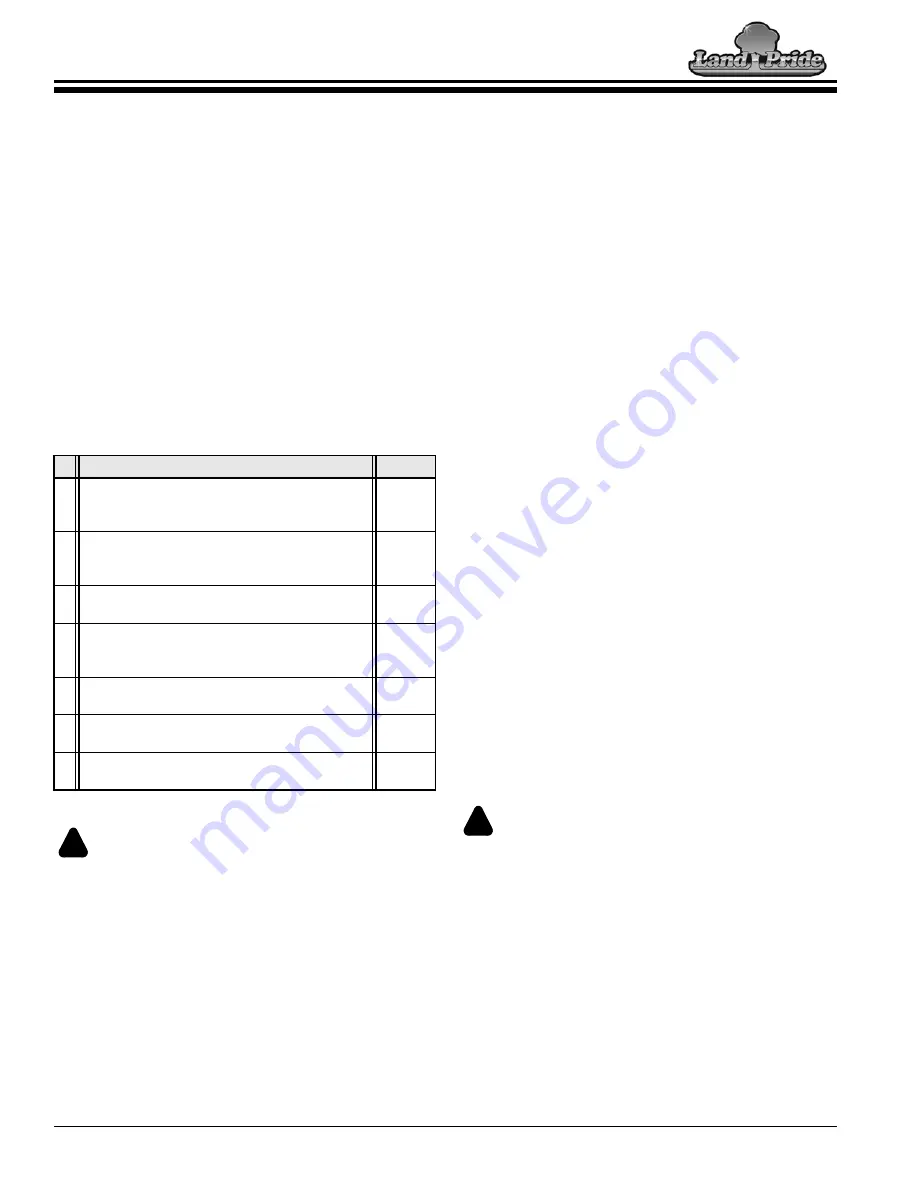
Section 3: Operating Instructions
Table of Contents
8/22/23
RC4615 & RCM4615 Rotary Cutters 331-644M
32
Section 3: Operating Instructions
Startup Checklist
Hazard control and accident prevention are dependent
upon the awareness, concern, prudence, and proper
training involved in the operation, transport, storage, and
maintenance of the Rotary Cutter. Therefore, it is
absolutely essential that no one operates cutter unless
they have read, fully understood, and are totally familiar
with the Operator’s Manual. Make sure the operator has
paid particular attention to:
•
Important Safety Information
, pages 1
•
Section 1: Assembly & Set-up,
page 14
•
Section 2: Adjustments
, page 28
•
Section 3: Operating Instructions
, page 32
•
Section 4: Options & Accessories
, page 40
•
Section 5: Maintenance & Lubrication
, page 43
Perform the following inspections before using your
Rotary Cutter.
Safety Information
DANGER
!
To avoid serious injury or death:
•
Always disconnect driveline from the tractor and secure the
implement in the up position with solid, non-concrete
supports before servicing the underside. A person can
become entangled in the drivetrain if the tractor is started
and power take-off is engaged or crushed by an
unsupported implement
•
Tractor power take-off shaft shield, driveline shields, and
gearbox shaft shields must be installed and in good working
condition to avoid driveline entanglement and projectiles
flying off of the driveline.
Operating Checklist
Check
Page
Make sure all guards, and shields are in place
and in good working condition. Refer to
“Important Safety Information”.
1
Follow hook-up and driveline installation
instructions.
Refer to "Section 1: Assembly & Set-up".
17
Make all required adjustments.
Refer to "Section 2: Adjustments".
28
Preform all required maintenance.
Refer to "Section 5: Maintenance &
Lubrication".
43
Lubricate cutter and driveline as needed.
Refer to "Lubrication Points".
50
Lubricate all gearboxes and replace oil plugs
properly. Refer to Gearbox lubrication.
53
Check cutter initially and periodically for loose
bolts and pins. Refer to “Torque Values Chart”.
61
•
Do not engage power take-off while connecting or
disconnecting the driveline, or while someone is standing
near the driveline. A person’s body and/or clothing can
become entangled in the driveline.
•
Never place hands or feet under the deck or attempt to make
adjustments to the cutter with power take-off engaged.
Cutter blades rotating at high speeds cannot be seen and are
located close to the deck sides. Body extremities will be cut
off instantly.
•
Rotary Cutters have the ability to discharge objects at high
speeds; therefore, the use of front & rear safety guards is
mandatory with this cutter. Double row chain guards should
be used when cutting along roadways and in areas where
people may be present. Stop blade rotation if bystanders are
in or around the area. It is recommended that a safety shield
be placed between the operator and cutter on an open air
tractor.
•
Do not raise one or both wings up with power take-off
engaged or drivelines rotating. Objects can be thrown by
rotating blades. Always keep people away from a cutter that
is operating.
•
Do not use cutter as a fan. Cutting blades are not properly
designed or guarded for this use.
•
This cutter is equipped with free-swinging cutting blades to
reduce shock loads. However, it is best to avoid striking
solid objects for your safety and to protect the cutter from
damage.
•
Do not use a power take-off adapter. The adapter will
increase strain on the tractor’s power take-off shaft causing
possible damage to shaft and driveline. It will also defeat
the purpose of the tractor’s power take-off shield.
•
The cutter must be operated with both wings attached.
Removing one wing will increase risk of rollover. Removing
one or both wings will expose the blades. Rotating blades
will cut body extremities and throw objects.
•
Clear area to be cut of debris and other unforeseen
removable objects before cutting. Mark non-removable
hazards such as tree stumps, post stubs, protruding objects,
rocks, drop-offs, holes, etc. with a visible flag.
WARNING
!
To avoid serious injury or death:
•
Do not use a tractor that is too small or too large. Small
tractors can be pushed around and flipped over. Large
tractors can damage the attached implement. See “Tractor
Requirements” at the front of Section 1: Assembly & Set-up.
•
Do not operate and/or travel across inclines where the
tractor and/or implement can rollover. Consult your
tractor’s manual for acceptable inclines the tractor is
capable of traveling across.
•
Operate only power machines equipped with a certified
Roll-Over Protective Structure (ROPS) and seat belt. Keep
folding ROPS in the “locked up” position when
appropriate. If ROPS is in the locked up position, fasten seat
belt snugly and securely to help protect against serious
injury or death from falling and machine overturn.

















































